Inductive Reasoning tests are tests that assess your ability to get to the right conclusion based on a series of events or examples. Unlike deductive reasoning tests, in which you get to a conclusion based on a given set of rules, on inductive reasoning tests you assume what are the rules or logic that govern the set of examples, and then you find the correct answer based on your assumptions.
Did you know?
Inductive Reasoning Tests assess the ability to reach conclusions based on just a few examples. On aptitude tests, inductive reasoning sections usually utilize abstract shapes and have four basic types of questions: (1) series completion, (2) matrix completion, (3) finding the object that doesn’t belong, and (4) shape analogies. Test takers who can think both conceptually and analytically perform well on these types of tests.
Most of the inductive reasoning tests are non-verbal in nature – they use figural and symbolic elements rather than using numbers and words. Here are four of the most common types of non-verbal inductive reasoning questions.
Question Types Explained
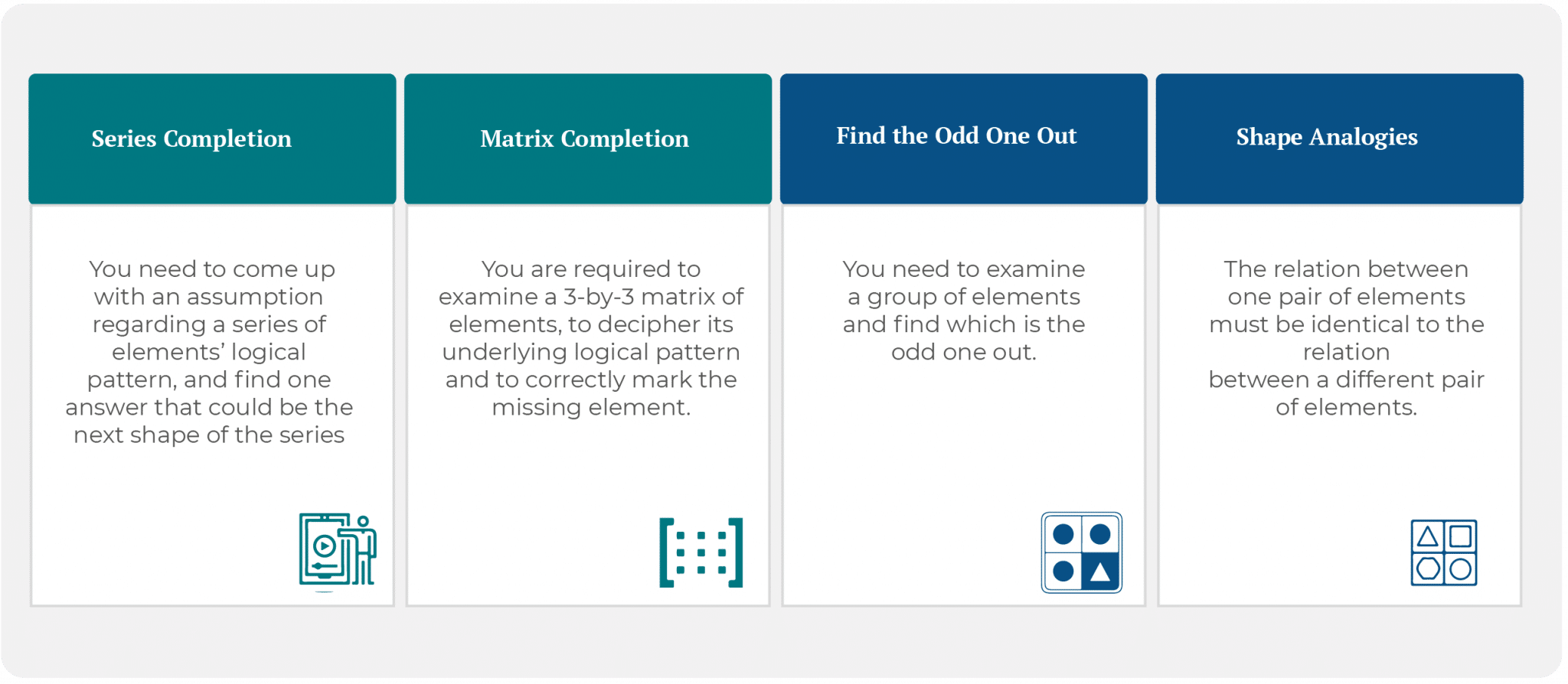
1. Inductive Reasoning Series Completion
This is probably the most common type of inductive reasoning questions. You are required to examine a series of elements, which follow a certain logical pattern. You need to come up with an assumption regarding the series’ logical pattern and find one answer that could be the next shape of the series, given that it maintains that logical pattern.
The series is usually comprised of 3-5 elements and there are usually 4-6 options to choose the correct answer from. A variation of this type of question is the completion of an element in the middle of a given series of shapes.
Try a Series Completion Sample Question
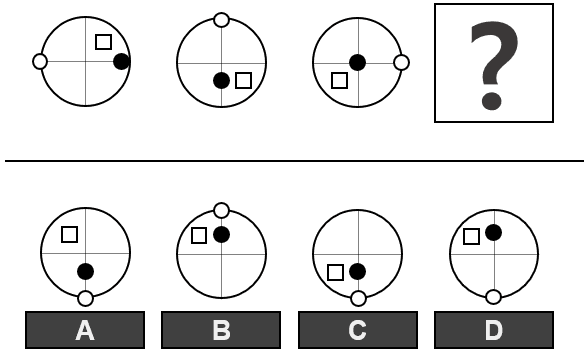
Answer: A
Explanation
Each element is comprised of a square divided by two lines and of three shapes—a black circle, a white circle, and a white square. The logic of the series is based on two processes:
- In each step, the element is rotated 90 degrees clockwise. The rotation cannot be recognized if one only looks at the big circle and the lines because of its symmetry; however, you can follow the white circle and the white square and realize that they maintain their relative positions. Assuming the trend continues, and the element is rotated 90 degrees again, then answers A and D represent the expected positions of the white circle and the white square.
- In addition to the rotation, the black circle moves along the line it is initially positioned on. In each step, the black circle gets closer to the white circle, which is the case in answers A, B, and C.
Altogether, only answer A displays an accurate combination of both of the processes.
2. Inductive Reasoning Matrix Completion
In this type of question, you are required to examine a 3-by-3 matrix of elements, to decipher its underlying logical pattern and to correctly mark the missing element. The logical pattern may be related to the matrix’s rows, columns, diagonals, or a combination of these.
Try a Matrix Completion Sample Question
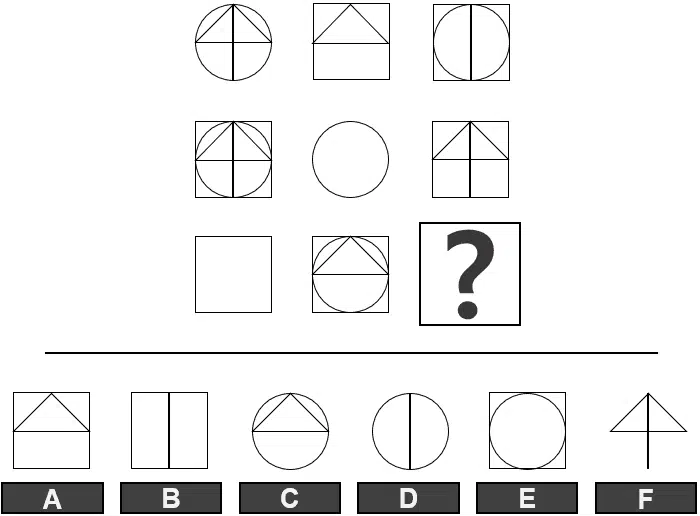
Answer: C
Explanation
Take any two elements of one column or of one row and compare them. If they share a feature, then the third element of that column/row does not include that same feature. On the contrary, if there is a feature that appears in only one of them, it is included in the third element as well.
For example, in the left column – the top and the middle elements are identical except for the square that surrounds the middle element. Therefore, none of the features comprise the bottom element but the surrounding square.
The missing element – the left two elements of the bottom row share one feature, a square. The features inside the square of the bottom middle element are unique to that element, and the bottom left element has no unique features. The missing element, thus, is identical to the unique features of the bottom middle element – a triangle within a circle.
3. Inductive Reasoning Finding the Odd One Out
In a different take on inductive thinking, in these questions, you need to examine a group of elements and to realize which distinct characteristic is common to all elements of the group but one. That element is the odd one out.
Try an Odd-One-Out Sample Question

Answer: E
Explanation
The base of each of the shapes within the elements is at the bottom except for shape E, whose base is at the top.
Note that in order for an element to be the odd one out, it needs to be truly unique. In this example, only element C contains a triangle. One may claim that this makes it the odd one out. However, elements B and D contain quadrangles, and elements A and E contain pentagons. This means that for the property “number of edges,” elements A, B, D, and E do not share the same characteristic. This means that element C is not the odd one out.
4. Inductive Reasoning Shape Analogies
In this type of question, inductive reasoning is working at its best. You need to come up with a logical explanation and find the correct answer based on a single example. As in verbal analogy questions, the relation or differences between one pair of elements must be identical to relation/differences between a different pair of elements.
Try a Shape Analogy Sample Question
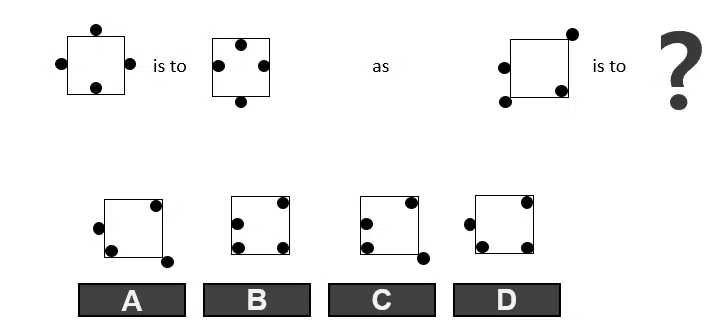
Answer: C
Explanation
In the pair at the left, every circle that was attached to the square from the outside moves to the adjacent position inside the square. Respectively, every circle that is attached to the square from the inside moves to the adjacent position outside the square.
In order to maintain the analogy, the same rule must apply to the pair at the right.
Answer C does just that – three circles that were outside of the visible element of the pair at the right move inside, and one circle that was inside the element moves outside.
iPREP: Concise. Focused. What you need.
Sign up
Immediate access
Practice
Online self-paced
Pass
Ace that Test!
Technical Facts
Inductive Reasoning Test Fast Facts (tl;dr)
- Non-verbal questions.
- Usually given by SHL.
- Question types: Series completion, matrix completion, odd one out, shape analogies.
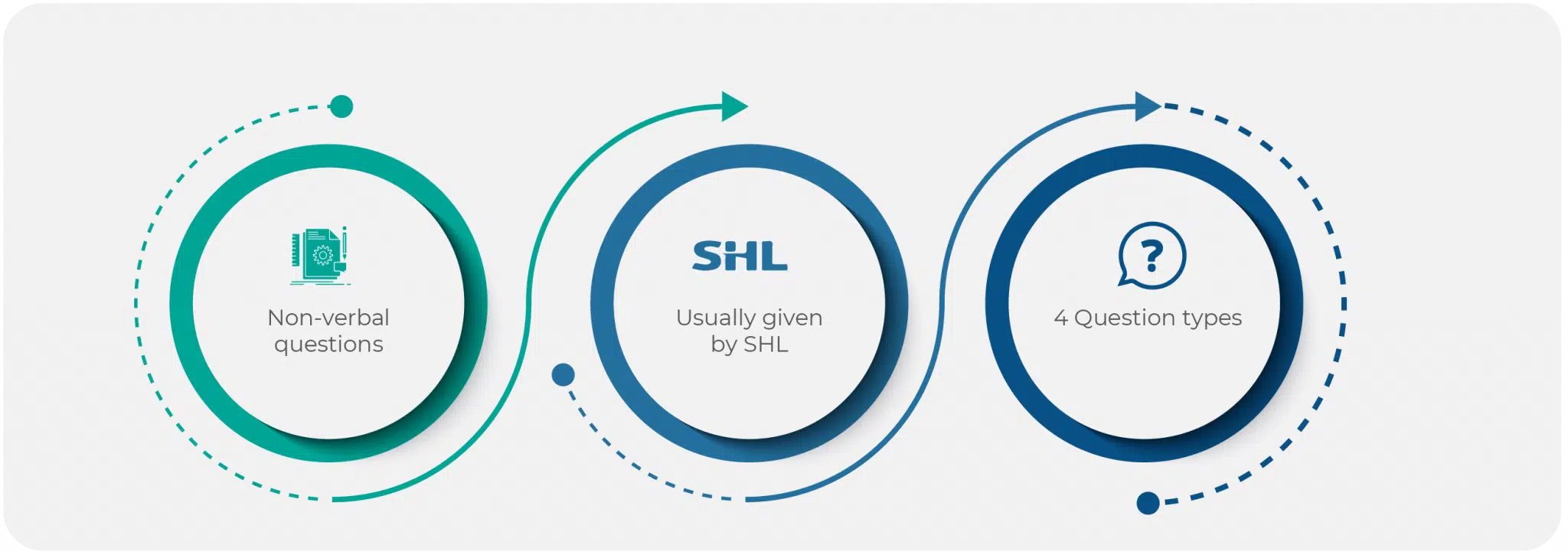
SHL Inductive Reasoning
SHL, probably the world’s largest provider of inductive Reasoning tests had this to say about it: “These tests measure the ability to work flexibly with unfamiliar information and find solutions. People who perform well on these tests tend to have a greater capacity to think conceptually as well as analytically.” (source: couriermail.com)
Common names of the test
- Inductive Reasoning
- Diagramatic Reasoning
- Abstract Reasoning
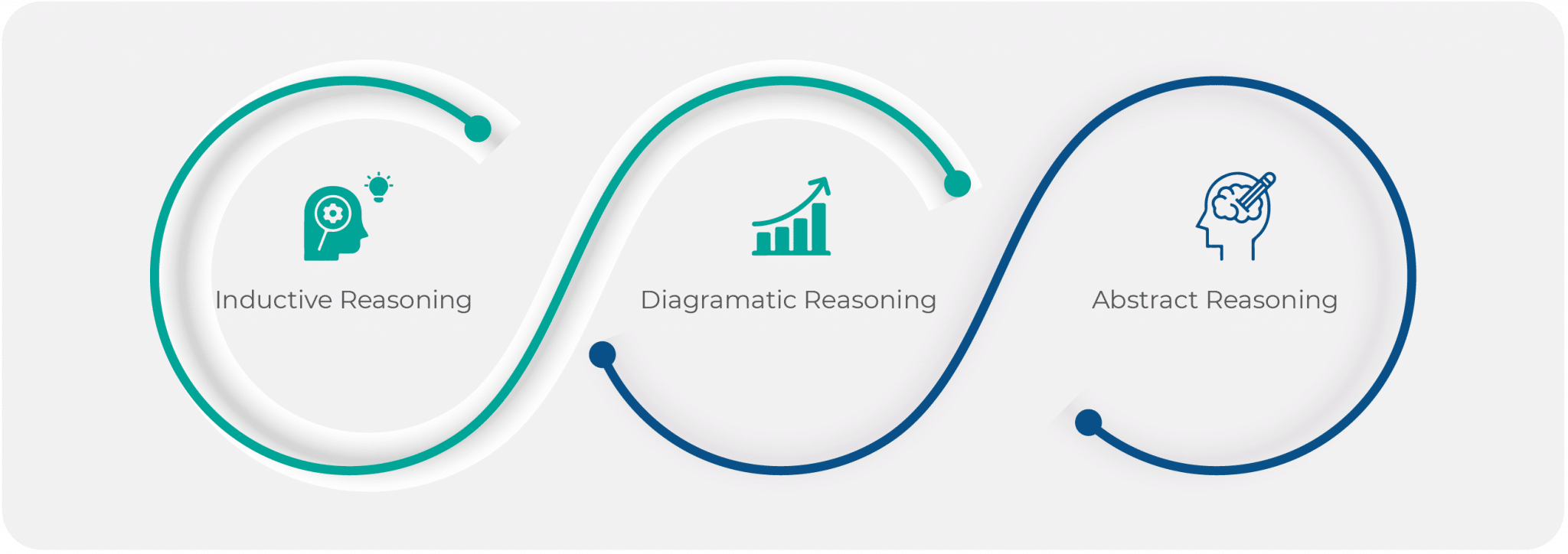
Inductive Reasoning FAQs
The Inductive Reasoning Test is a pre-employment assessment test that measures a candidate’s inductive reasoning skills. This test, usually by SHL, proves to HR and hiring managers that you have the ability to take information and draw a conclusion. If you take the time to study and practice, you will feel more confident during test-time and, consequently, score higher, proving to your future employers that you are a good enough candidate to move on to the next step in the recruitment process and, ultimately, join the team.
The Inductive Reasoning Test may be comprised of non-verbal questions in the following categories:
– Series completion
– Matrix completion
– Odd one out
– Shape analogies
Inductive Reasoning Test Tips
1. Read through the instructions
Review the question and possible answers quickly, yet thoroughly. Scan the information for relevant data and apply it to reach the right answer.
2. Manage your time:
Don’t spend too much time on any one particular question. Remember that you have limited time to complete the test. If you encounter a tough question that you can’t immediately answer, take your best guess and move on to the next one.

3. Know your strengths
Don’t worry about not getting all the answers right. However, you should at least get a score above the average or within the score range required for a particular job.
4. Try to correctly answer as many questions as you can:
If you don’t know the actual answer to a question, you can at least start the process of elimination by removing the answers that sound extremely far-fetched.
5. Plan your Inductive Reasoning Test strategy:
While you are preparing for the test, take the time to read the instructions carefully so you can plan your test strategy and get the highest score possible. Avoid reading the instructions during the real test—you should know them before you even walk into the testing center.
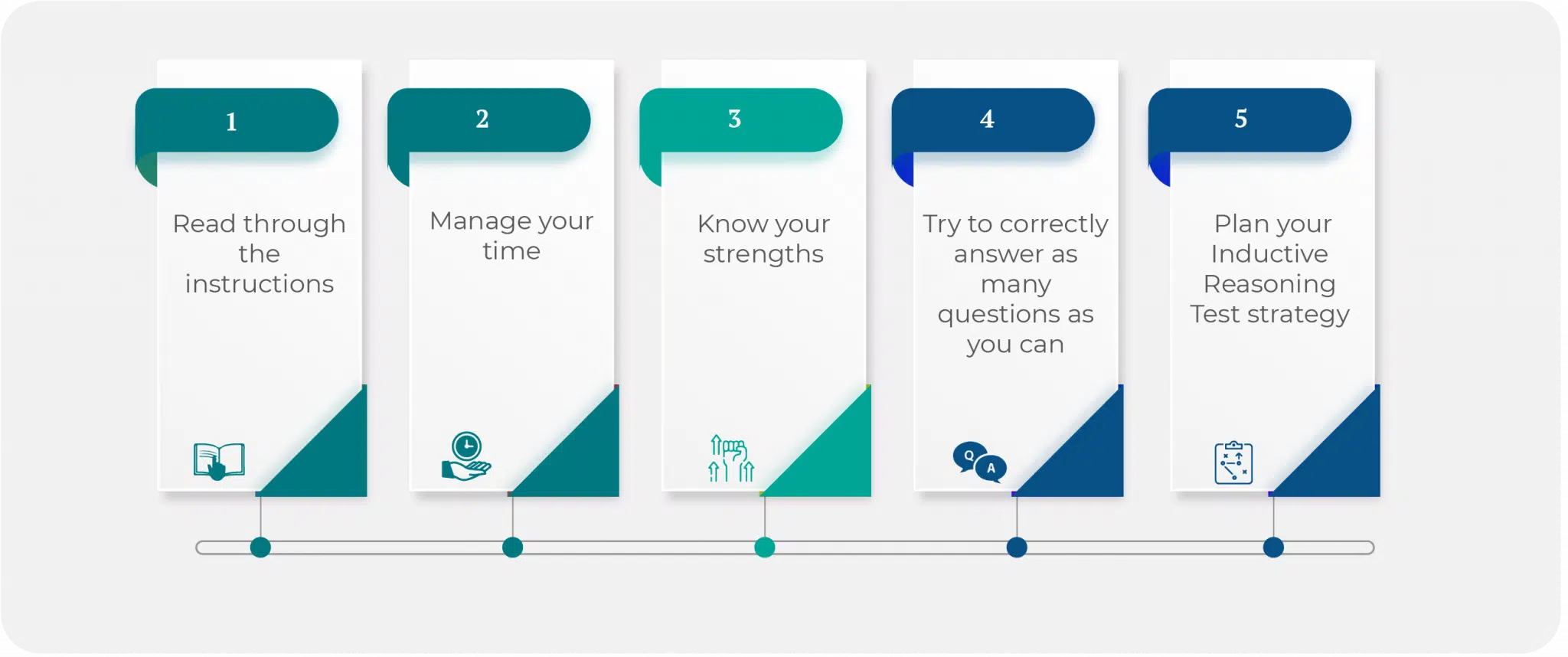
Free Inductive Reasoning practice test: Get to know what Inductive Reasoning Tests are like by practicing with these sample questions:
Question 1 of 15
Which of the following boxes should replace the question mark (?) to complete the pattern?
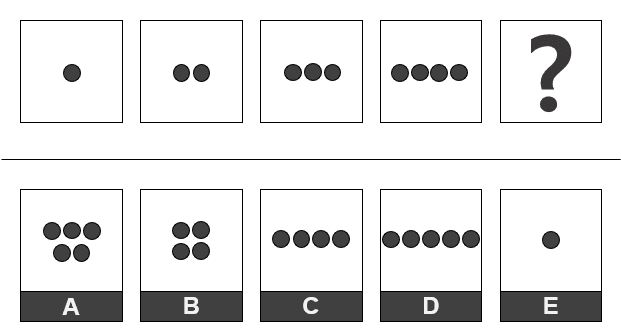
The correct answer is D.
Explanation:
In each element, from left to right, there is an additional circle. All circles are aligned horizontally. As the last element includes four circles, the next element should include five circles aligned horizontally.
Solving Tip:
The simple explanation you formulate should encompass all the existing characteristics within the elements. For example, option A consists of five circles as well, but they are not aligned horizontally. This is why option D is a better answer.
Question 2 of 15
Which of the following boxes should replace the question mark (?) to complete the pattern?
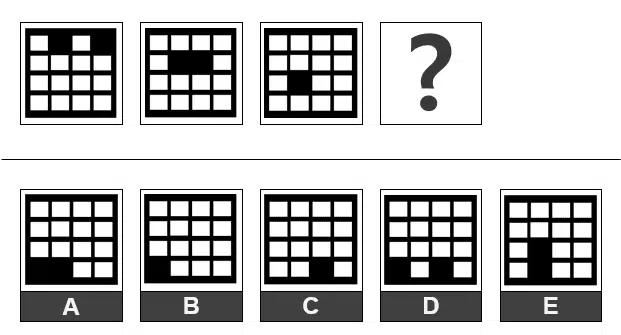
The correct answer is A.
Explanation: Each element contains a 4×4 grid of rectangular cells. In the first element, two cells are highlighted. From left to right, the top left highlighted cell moves one cell down in each step; the top right highlighted cell moves one step diagonally down and left. In the third element, both highlighted cells overlap and seem as if only a single cell is highlighted. If the same movement pattern continues, then the cell at the bottom left corner and the cell adjacent to it from the right should be highlighted, as portrayed in option A.
Solving Tip:
The most common changes in pattern in questions of similar style are:
- Movement up-down/left-right/diagonally
- A movement along the edges of the frame (can be a steady or increasing number of steps in each movement)
- Rotation of the entire element
Question 3 of 15
All the figures below but one share a common feature. Which of the following does not share that feature?

The correct answer is D.
Explanation: Each element contains four straight lines. In all elements but D, one of the lines intersects with an additional one or two lines. Since there are no intersections in element D, it is the odd one out.
Question 4 of 15
All the figures below but one share a common feature. Which of the following does not share that feature?

The correct answer is E.
Explanation: All elements contain one shape within another. In all elements but E, the outer shape has more edges than the inner shape.
Question 5 of 15
Which of the following boxes should replace the question mark (?) to complete the pattern?
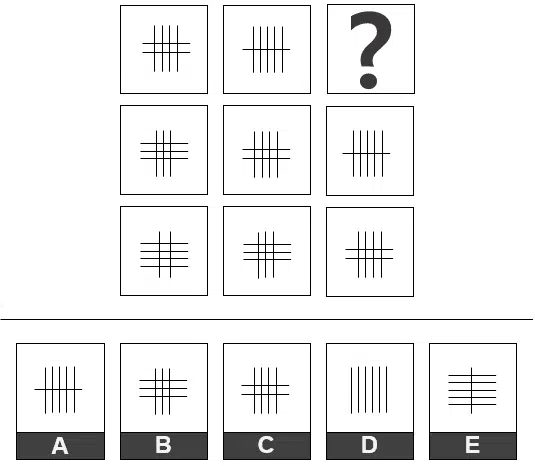
The correct answer is D.
Explanation:
The solution is a product of understanding the combined logic of rows and columns.
Logic by row – From left to right, each element includes one additional vertical line and one fewer horizontal line.
Logic by column – From top to bottom, each element includes one additional horizontal line and one fewer vertical line.
According to the combination of the above, the missing element must include six vertical lines and zero horizontal lines, exactly as in option D.
Question 6 of 15
Which of the following boxes should replace the question mark (?) to complete the pattern?
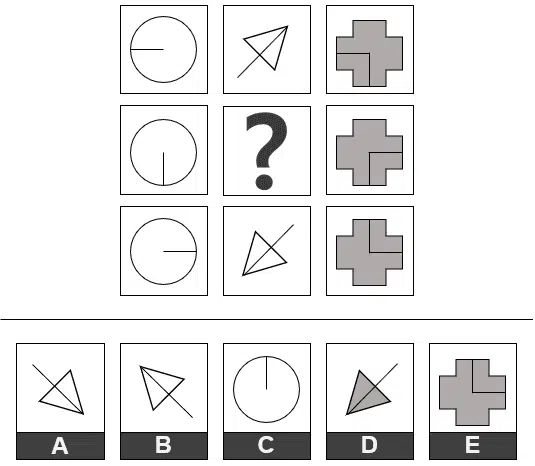
The correct answer is B.
Explanation: the solution in this case goes only according to the logic by column. On each column, from top to bottom, the elements within the frame rotate 90 degrees counterclockwise. According to this, you can expect that the arrow-shaped figure will point at the top left corner of the frame. Option A presents a rotation of the same shape clockwise and not counterclockwise.
Question 7 of 15
Complete the analogy.
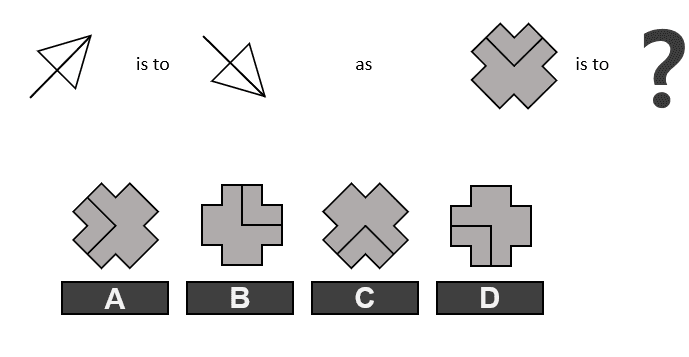
The correct answer is C.
Explanation: The second element is a vertical flip of the first one. Option C is a vertical flip of the third element; therefore, it is the correct answer.
Solving Tips:
- At times, one difference can be described in several different ways. Each description may yield a different expected missing element. Notice that the second element can also be described as a 90-degree rotation of the first. If you assume that this is the correct analogy, then you will not find a fitting answer among the options. In such cases, you would have to go back and rephrase the analogy.
- Rotation, flipping, and symmetry are all common elements used on cognitive ability tests. Keep them in mind when examining analogies between elements that have the same structure but different orientations.
Question 8 of 15
Complete the analogy
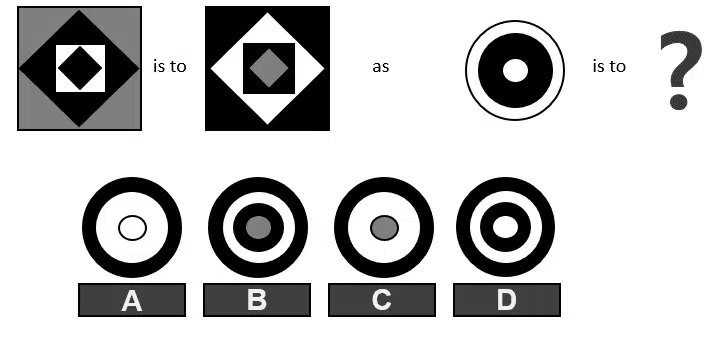
The correct answer is A.
Explanation:
Each element is comprised of shapes one on top of the other.
The logic of the analogy: following the order of the shapes, from inside out, the color of each shape of the first element becomes the color of the next shape in size in the second element; that is, except for the color of the outermost shape, which becomes the color of the innermost shape of the second element.
You may try reducing this analogy to a sequence of words. This way, you can see that the last word of the first element becomes the first word of the second element and the rest of the words maintain their order:
First element = black, white, black, gray;
Second element = gray, black, white, black.
According to that, the third element demonstrates this sequence: white, black, white.
Therefore, the missing element should demonstrate “white, white, black,” as in option A.
Question 9 of 15
Which of the following boxes should replace the question mark (?) to complete the pattern?
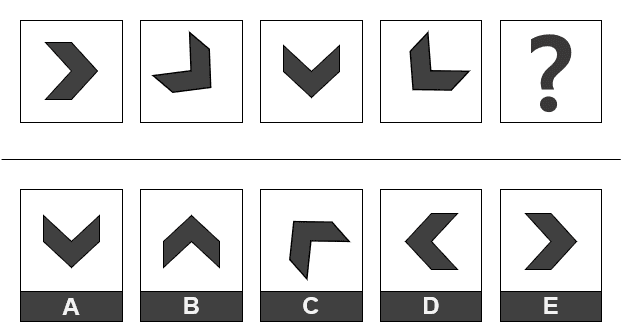
The correct answer is D.
Explanation: The shape within the element rotates 45 degrees clockwise with each step.
Solving Tip:
Use whatever tools you may have in order to get the correct answer. Sometimes, using finger gestures or partially hiding the element might help the brain to decipher the logic of the sequence.
Question 10 of 15
Which of the following boxes should replace the question mark (?) to complete the pattern?
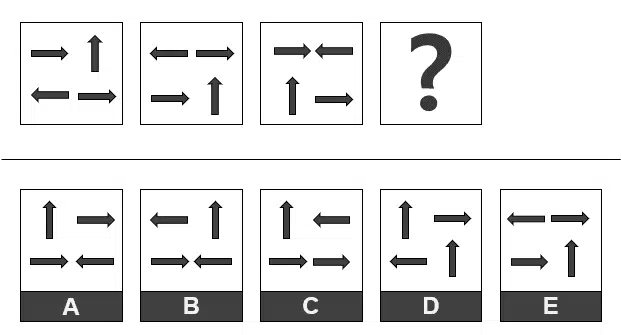
The correct answer is A.
Explanation: Each element in the sequence contains four inner shapes. Imagine that each element is divided into four quarters as described in this chart:

In every step, each of the four elements moves to an adjacent quarter clockwise (1 → 2; 2 → 3; 3 → 4; 4 → 1).
Solving Tip:
Arrows might be very distracting. One tends to assume that their direction must be significant to the logic of the question. But this is not always the case. In this question, each arrow is simply an inner shape and its direction is irrelevant to the solution.
Question 11 of 15
The two figures above share a common feature. One of the figures below does NOT share this same feature. Which figure below does NOT share this common feature?
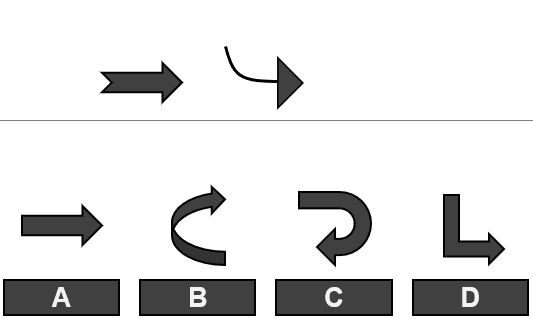
The correct answer is C.
Explanation:
All arrows except answer C point to the right.
Solving Tip:
- Answer B is different from the rest of the options because it has a bend in the middle, which creates two colored sections while the other options have one continuous section. Notwithstanding, this feature is not different from a common feature of the shapes above the line; therefore, it is not the odd one out.
Question 12 of 15
The two figures above share a common feature. One of the figures below does NOT share this same feature. Which figure below does NOT share the common feature?
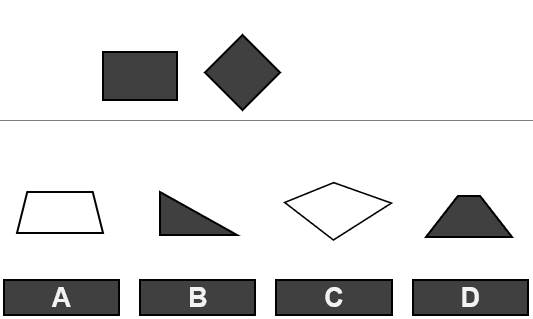
The correct answer is B.
Explanation:
All the elements are quadrangles except B, which is a triangle.
Solving Tips:
- Answer C may seem different because it is the only shape below the line that does not have vertical or horizontal lines and it stands on its vertex. However, the diamond above the line also stands on its vertex and has no vertical or horizontal lines; therefore answer C is incorrect.
- Answers A and C are white while the other shapes are not. Even though it is a characteristic that is significantly different from the shapes above the line, it exists within two of the shapes below the line and therefore cannot be the characteristic that helps to determine the odd one out.
Question 13 of 15
Which of the following boxes should replace the question mark (?) to complete the pattern?
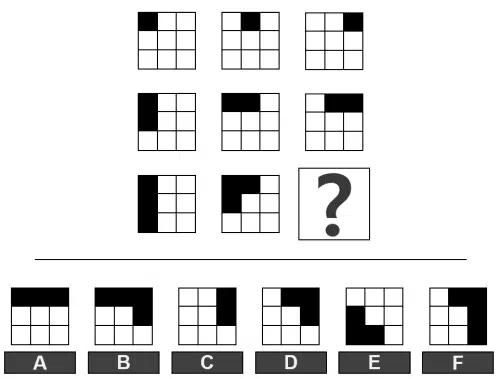
The correct answer is A.
Explanation: the solution is a product of understanding the 2×2 Steps logic of the matrix.
Consider element 1 as the starting position – a single square on a 3×3 grid of squares. Let’s name it the “snake.”
Steps to the right – the snake moves/crawls one step clockwise along the outline of the grid.
Notice the difference between elements 6 and 7. The snake is three squares long and since it moves one step clockwise it creates a corner-like shape.
Steps down – the snake grows and adds another black square to its size. The growth always goes along the outline of the grid in a counterclockwise direction.
The missing element is supposed to take two steps to the right and two steps down. The easiest way to find it is to take either element 3 or element 7 and take the steps from there.
If you take element 3 as the starting point, then the snake grows two steps to the left and forms a 3-square-long top row.
If you take element 7 as the starting point, then the snake crawls along the outline of the grid clockwise and ends up “resting” horizontally at the top.
Question 14 of 15
Which of the following should replace the question mark (?) to complete the pattern?
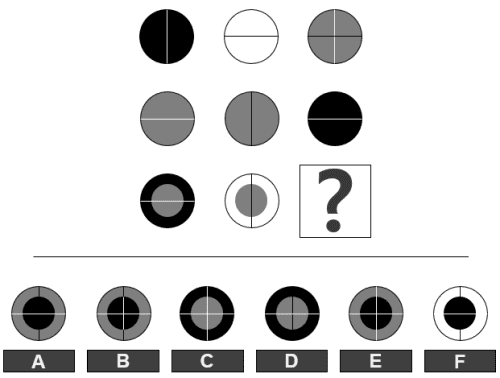
The correct answer is A.
Explanation: the solution is arrived at by understanding the logic of the matrix by rows.
The elements of the right column are a product of a “function” that takes into account the left and middle elements.
By examining the first row you learn that a black color (left circle) and white color (middle circle) produce gray color (right circle). You also learn that both diameters, which are part of the left and middle circles, appear on the right circle. Notice that the diameters maintain their color.
By examining the second row you learn that gray and gray produce black. You can also confirm the conclusion regarding the diameters. Notice that the black vertical diameter of the middle element is concealed because it has the same color as the right circle.
The missing element is a product of combining the logic you deciphered through the top and middle rows. Since the outer part of the left circle is black and the equivalent part of the middle circle is white, then the outer part of the missing circle should be gray. Comparably, the inner part of the right circle should be black because the inner parts of both the left and the middle circles are gray.
Examining options A-F, you can eliminate options C, D, and F. The remaining options have the same colors but display different diameters. If the importance of the diameters was not regarded till this point, one should conclude that it is of importance. According to the conclusion regarding the diameters, you expect both the diameters of the left and middle circles to appear and maintain their color. Hence, option A is the correct answer because the horizontal diameter is white and the vertical diameter is black. Although it is partially concealed by the black shade of the inner part of the circle, it is still there.
Question 15 of 15
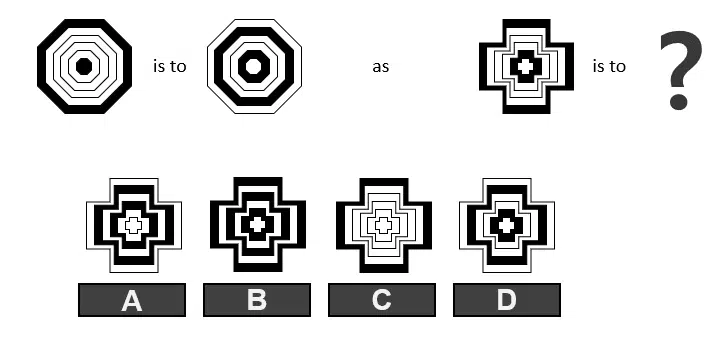
The correct answer is A.
Explanation:
Each element is comprised of six similar shapes, one on top of the other.
The difference between elements ONE and TWO:
- The black filling of the outermost shape of the first element shifts to the nearest smaller shape of the second element.
- The black filling of the innermost shape of the first element shifts to the nearest bigger shape of the second element.
Solving Tip:
- There are alternative ways to describe the analogy, but as long as there are no options that fit the alternative description, it cannot be accepted as the correct analogy. Never assume that there is a problem with the test.
- For example, one could claim that it is not a shift of the colored sections but a switch: the largest and second-largest shapes switch colors and the smallest and second-smallest shapes switch colors. In such a case, you would expect to see the image below as an option. Since you do not see it, you have to come up with an alternative description of the differences.
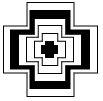
Well done!
You have completed the Sample Questions section.
The complete iPREP course includes full test simulations with detailed explanations and study guides.
‘…TESTS THAT ACTUALLY HELP’

In the first 30 minutes of use I have learned so much more than skipping along the internet looking for free content. Don’t waste you time, pay and get tests that actually help.
Richard Rodgers
January 28, 2020 at 7:49 PM
About the course
Welcome to iPREP’s comprehensive Inductive Reasoning Course. If you’re looking to enhance your non-verbal reasoning skills, you’ve come to the right place. Inductive reasoning, also known as abstract or figural reasoning, is crucial for solving complex problems that involve identifying patterns and making predictions based on observed data. This course is designed to help you master these skills through structured lessons and practice tests.
Course Structure
This course provides a systematic approach to mastering inductive reasoning. Each unit delves into a specific type of question, followed by practice drills with detailed solutions. This comprehensive approach ensures you understand the underlying logic and develop the skills needed to excel.
5
Learning hours
14
Practice tests
200
Questions
30
Day access
Four Types of Figural Reasoning Questions
- Visual Analogy: Identify the relationship between pairs of images and apply the same logic to a given image and multiple-choice options.
- Series Completion: Recognize patterns in a series of shapes to identify the missing element.
- Matrix Completion: Determine the missing element in a matrix of shapes by identifying the underlying pattern.
- Finding the Odd-One-Out: Identify the element that does not conform to the common pattern in a set.
Embark on this learning journey with iPREP and unlock your potential in inductive reasoning. Our goal is to empower you with the skills and confidence to tackle any figural reasoning test with ease.
Skills you will learn
Visual Analogy
Series Completion
Matrix Completion
Odd-One-Out
Curriculum
- Course Introduction
- Introduction to Inductive Reasoning
- Inductive & Abstract Reasoning Warm-up
- Guides & Practice Tests by Type of Question:
- Figural Series Completion
- Matrix Completion
- Visual Analogy
- Finding the Odd-One-Out
- Course Conclusion
Customer testimonial

The practice tests are very helpful in preparing for pre-employment assessments. The Inductive & Abstract Reasoning tests are nearly identical to those used by many employers today to evaluate cognitive aptitude, so it gave me a good idea of where I stood going in. I especially liked how the practice test answers described in detail the logic behind each answer. Very helpful in “training” your mind to think clearly and calm the nerves. Best test prep ever!
Julie Nesbitt
2022/11/01 at 1:30 pm
Reviews

Andreas S********
May 26, 2024 at 6:59 PM
Very good, nice with explanations, guides and tricks. Matrices, odd ones out, shape analogies, etc are covered in thorough detail

Morten I******
May 14, 2024 at 2:41 PM
Great preparation before job interview! I really appreciate this great opportunity you have here. Now i feel a lot more confident

Filipe P****
May 14, 2024 at 3:19 AM
Thank you very much! This course helped on my confidence. Very quick practice and assessment on where you stand. I will recommend this website for my friends.

Filipe P****
May 4, 2024 at 12:47 AM
My confidence increases after each section, even more by reading reading through explanations and the tips and tricks. What a great preparation!

Ekaterina S******
April 30, 2024 at 4:14 PM
Amazing practice test. Great explanation. Feel more confident after practicing each section. Will highly recommend to anyone! Just practice, practice and practice!

Emmanuel J
April 13, 2024 at 2:47 PM
Very well built prep test. And the structured approach with benchmark with other test taker gives a clear idea of where you stand.

franky s******
April 13, 2024 at 2:08 AM
Good content and it is useful for me as it belongs to my wishes. Maybe it can be added more difficult question

Leonardo C*********
April 1, 2024 at 8:04 PM
It was a great experience. Show me new ways to enfocate my attention in this kind of questions and allow me realize what kind of questions could be in this exams.

Chris N***
March 28, 2024 at 3:19 PM
Really helpful in preparing for inductive reasoning tests, I feel more confident now to pass the test with good enough results

MANDANI K************
February 29, 2024 at 8:22 AM
Very enlightening courses, useful tips and tests. I really think that after the prep experience i will be ready for my job test!
